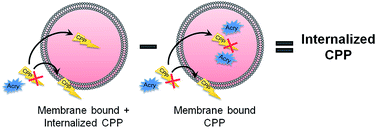Label-free quantification of cell-penetrating peptide translocation into liposomes†
Abstract
Cell penetrating peptides (CPPs) are small molecules capable of crossing lipid membranes and transporting cargos of varied sizes and nature inside cells. Two cellular uptake mechanisms have been identified: endocytosis and direct translocation through the cellular membrane. Several methods have been proposed to follow and quantify CPP internalization ability both in cells and liposomes, most of them requiring the addition of some sort of label to the CPP. Herein we propose a protocol to test and quantify the translocation ability of CPPs through liposomes by measuring their intrinsic Trp fluorescence and their quenching by acrylamide. Although restrained to CPPs that possess at least one Trp residue in their sequence, the protocol remains applicable to a great number of CPPs. The protocol was applied to three CPPs, including one of the first discovered (penetratin), for their internalization into zwitterionic and anionic liposomes and upon different incubation times. While penetratin and one of its analogs were able to translocate into anionic liposomes, none of the peptides translocated into zwitterionic ones. The newly developed protocol allows for the detection of nanomolar amounts of CPPs inside liposomes. The results obtained are in very good agreement with those determined by other quantification methods.


 Please wait while we load your content...
Please wait while we load your content...